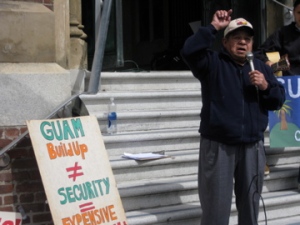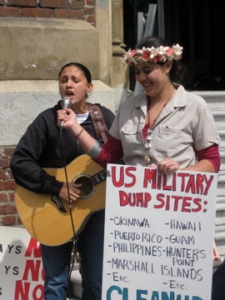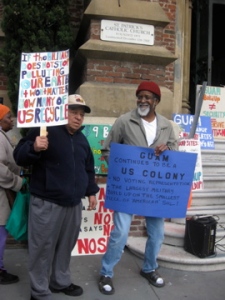http://www.washingtonpost.com/wp-dyn/content/article/2010/04/21/AR2010042105397.html?wpisrc=nl_headline
Plans to allow women and gays, ban smoking shake world of Navy submarines
By Craig Whitlock
Washington Post Staff Writer
Thursday, April 22, 2010
Imagine 150 fraternity brothers packed into a container the size of a three-bedroom house. Announce you are breaking hallowed traditions by taking away their cigarettes and admitting women. Then lock the doors and push the container deep into the sea, for months at a time.
That’s what the Navy, after decades of contemplation and controversy, has decided to do with its Submarine Force, an elite fraternity of 13,000 active-duty sailors that has been patrolling the oceans for 110 years.
As of Dec. 31, smoking aboard the entire submarine fleet will be summarily banned — no small hardship for the estimated 35 to 40 percent of sailors who are nicotine addicts and can’t exactly step outside whenever they want a puff.
Barring intervention by Congress in the next few days, the Navy has also said it intends to let women join submarine crews by the end of 2011, a move that isn’t going over well with many active-duty and veteran members of the Silent Service, the stealthy nickname of the force.
On top of all that, the military is girding for another social revolution that might take some getting used to inside the cheek-to-jowl confines of submarines: allowing gays and lesbians to serve openly in the ranks.
“The Silent Service is right now very much a boys’ club,” said Joe Buff, a military commentator and the author of six pulp fiction thrillers involving submarine adventures. “They’re always bellyaching, and they always hate change. But I think the men are going to be better at all these changes than they’re willing to let on.”
One active-duty lieutenant said he personally supported the changes but worried about the effect on crews, who have long relied on tobacco and male banter to ease the boredom of serving in a confined space. “There’s very few avenues of stress relief,” he said, speaking on condition of anonymity because he didn’t want to be seen as challenging official policy. “You can smoke, or you can hang around and get creative with the conversation.”
Navy and Pentagon officials said the timing of the changes was coincidental but necessary. The Navy has been thinking about adding women to submarine crews since 1993, when female sailors began serving on surface warships. The military also has long expressed concern about the health risks of second-hand smoke on submarines, where the percentage of smokers is far higher than in the U.S. adult population at large.
Submarine commanders have been trying to reassure their crews — as well as lawmakers — about the changes. The Navy announced the smoking ban April 8 and said it would offer programs to help sailors kick the habit by the end of the year. After making noises last fall about letting women join the Submarine Force, the Defense Department formally notified Congress in February of its intentions. Congress has until the end of this month to weigh in, but so far it appears the decision is fait accompli.
As commander of Submarine Group 10, based at Kings Bay, Ga., Rear Adm. Barry L. Bruner has acknowledged in his blog that anxieties persist. “I have listened to concerns and understand that there will [be] some difficulties,” wrote Bruner, the leader of the Navy’s task force on integrating women into sub crews. “However, I have no doubt that it is the absolutely right thing to do and we are working hard to ensure a smooth transition.”
Not all bubbleheads, as submariners are commonly known, are convinced. Of all the pending changes, the introduction of women seems to be igniting the strongest reactions, according to interviews with active-duty and veteran sailors. The complaints often fall into two categories: first, that female sailors will invariably become pregnant, potentially compromising missions during which submarines can remain submerged for months at a time; and second, that submarines are not built for the mixing of the sexes, given the tight passageways, shared berths and lack of privacy.
Joseph Shook, a retired submariner from Texas, responded to Bruner’s blog with defiant comments, arguing that “over 99% do not wish to see it happen, all knowing it will not work as envisioned by whatever idiots have thought it up.”
Some of the backlash stems from a desire to preserve one of the few remaining public institutions in America where adult men can openly act like, well, young adult men. (Women sometimes board submarines as guests or as technicians on short-term assignments but are not assigned to crews.)
John A. Mason, a bubblehead who served in the Navy from 1977 to 1994, said he plans to submit to Congress written comments he has collected from 380 people opposed to adding women to sub crews. He said he has nothing against female sailors in the rest of the Navy but that underwater is another matter.
“Hormones do not shut down just because you go out to sea and submerge for many months at a time,” wrote Mason, 53, of Comer, Ga. He said sailors rely on various coping mechanisms to deal with the stress of extended deployments, including man hugs, rear-end patting and other rituals; another veteran cited a tradition in which submariners who cross the equator for the first time are required to strip to their underwear.
“Serving on board a submarine is not a place to be if you are self-conscious or have any doubts about your sexuality,” Mason added. “Silliness, male-bonding, and what might be considered inappropriate or ‘politically incorrect’ behavior in a civilian environment are all useful techniques that allow a sailor to endure the difficult living conditions and time away from their families and mainstream life.”
The Submarine Force plans to integrate women in phases. Female officers will join first and in groups, largely to prevent the likelihood of sexual harassment. The inaugural class will consist of women who graduate this year from the U.S. Naval Academy in Annapolis; those who sign up will attend the Navy’s submarine school in Groton, Conn. and receive other training before joining crews. At first, their service will be limited to fleet ballistic missile subs, also known as “boomers.” They are larger than the Navy’s fast-attack submarines, which will be harder to outfit with separate berths and bathrooms for women.
The Pentagon announced in February that it was also preparing for the integration of gay men and lesbians into the military, responding to President Obama’s call to end the “don’t ask, don’t tell” policy that requires them to keep their sexual orientation a secret. That change appears to have submariners less riled than the admission of women or the smoking ban.
“Everybody knows there are already homosexuals on our force, and I don’t think them being open about it will change anything on a boat,” said another active-duty lieutenant who spoke on condition of anonymity.
The lieutenant, a nonsmoker, said he would be grateful for the chance to breathe easier; although submarines are equipped with an extensive system of air filters, studies show they don’t screen out all tobacco-related substances. But the officer said that, taken together, all of the changes might be too much, too soon for others to handle.
“I’m worried that if you add women and remove smoking, some people will say, ‘Too much is changing; this isn’t what I like, and I’m going to get out,’ ” he said. “I don’t think you can remove cigarettes and add women and it not have some effect on the retention rate.”
Navy officials said they don’t anticipate a problem. In fact, they said one motivation in enabling women to serve on submarines is to increase their pool of potential recruits; it’s not always easy to persuade people to live and work underwater for months at a time in a cramped, steel tube.
“We literally could not run the Navy without women today,” Navy Secretary Ray Mabus said Wednesday, pointing to the decision 17 years ago to allow women to serve on warships. The decision to open the Silent Service to women, he added, was “probably long overdue.”

 COLUMBUS, Ohio (WOMENSENEWS)–When Diana Morgan saw her daughter’s body for the first time after her death in Iraq in February of 2008, she thought U.S. Army Spc. Keisha Marie Morgan looked angry in her coffin.
COLUMBUS, Ohio (WOMENSENEWS)–When Diana Morgan saw her daughter’s body for the first time after her death in Iraq in February of 2008, she thought U.S. Army Spc. Keisha Marie Morgan looked angry in her coffin.



